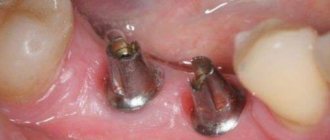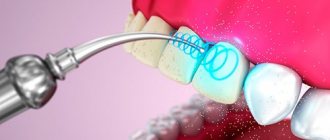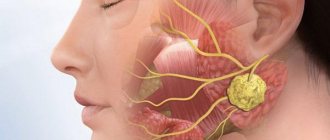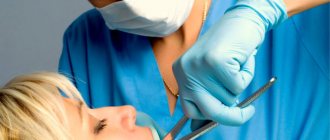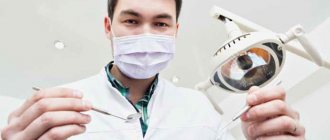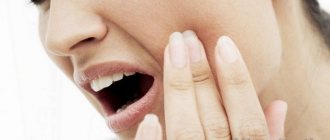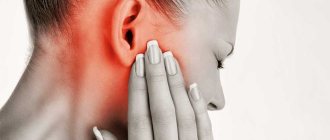A neighboring tooth hurts after extraction - a complaint with which patients often turn to the dentist. There are many reasons for this unpleasant symptom, most often it is damage to the gums, infection and the development of inflammation. It is recommended to consult a dentist.
How long have you had this pain syndrome?
- Several days (26%, 976)
- First day (21%, 799 Votes)
- Several months (12%, 452)
- Week (10%, 376)
- Several weeks (10%, 358)
- About a month (8%, 312)
- Chronic form (6%, 236)
- About a year (6%, 210)
Total voters: 3 720
Loading …
Use search Are you having a problem? Enter “Symptom” or “Name of the disease” into the form, press Enter and you will find out all the treatment for this problem or disease.
Why does the adjacent tooth hurt after extraction when pressed?
A significant portion of people go to see a dental surgeon with the hope that the pain will soon cease, but this does not always happen. Quite often there are complaints that after removal the neighboring tooth begins to hurt very much.
These symptoms can be caused by:
- Injury to the soft tissue of the gums and jaw. The discomfort usually goes away without assistance after a few days.
- Infection enters the tooth socket and causes inflammation or disruption of the integrity of its walls. The development of alveolitis is observed - a disease requiring qualified treatment.
- Shift of adjacent teeth into the area of the missing one. There is the appearance of discomfort and changes in the bite. Dentists do not advise delaying prosthetics.
- Caries in a nearby tooth that was not detected by the dentist.
Only a specialist can determine the cause of pain in teeth adjacent to the extracted one. If it does not go away after a few days or if its intensity increases, it is recommended to immediately contact a dental clinic.
Why do neighboring teeth hurt after being pulled out? Others, the one next to the number eight
When performing any of the extraction methods, the soft tissues of the oral cavity are damaged. Pain always occurs, but for different reasons.
After extracting the diseased tooth, it goes away within 2 days . For another two days the person will feel simple discomfort. But there are times when neighbors begin to get sick.
There are a number of reasons associated with this pain. Inflammation may form after poor removal . Or this happens due to mechanical damage.
Consequence of mechanical impact
After mechanical impact, cracks appear on neighboring teeth. This happens due to the fact that the dentist could disturb the neighboring ones with strong pressure with instruments.
A tooth bruise is also a mechanical injury, leading to damage to the enamel and more serious consequences .
A severe toothache begins, which intensifies directly with pressure.
What to do if a neighboring tooth hurts after extraction
To reduce the intensity of acute pain, it is recommended:
- refuse food after the procedure for at least 5 hours, and avoid hot foods for a day;
- apply a cold compress to the affected area;
- transfer the load while chewing food to the side opposite to the affected area;
- do not rinse the mouth in the first two days after the procedure;
- try to avoid contact of the tongue or foreign objects with the tooth socket.
If the pain syndrome bothers you for a long time, you can take medications:
- antihistamines – Suprastin, Tavegil;
- non-steroidal anti-inflammatory and painkillers;
- antibacterial agents.
If the pain continues to bother you after a few days, you can lightly rinse your mouth with a solution of furatsilin, soda, or a decoction of herbs with an anti-inflammatory and calming effect (calendula, chamomile).
The best option would be to seek help from a doctor; after examining, he will be able to determine the cause of pain in neighboring teeth and prescribe adequate therapy.
How to relieve pain?
Usually the painful sensation goes away on its own after a few days, but if this does not happen or the pain is hard to bear, you can use some remedies to alleviate the condition.
Doctors prescribe painkillers to patients after surgical procedures. In addition to medicines, you can use a variety of baths.
The following methods can be used to relieve pain:
- If you suffer from severe pain , you can take medications prescribed by the doctor or other painkillers, the dosage depends on the intensity of the pain. Ketanov is the most popular tablet for pain, two tablets are taken. every 6 hours. If the pain is acute, you can take Nurofen or Ibuprofen several times during the day. You cannot take pills at your own discretion; you must always follow the doctor’s recommendations or instructions.
- For the first few hours after removal, you can apply cold compresses to the cheek area. Using this method, you can get rid of unpleasant sensations, calm your nerves and promote the fastest healing of wounds.
- After several days, you can make baths with a mixture of baking soda, salt and 3-4 drops of iodine. Rinse as often as possible throughout the day.
- You can use baking soda and salt for the same procedures , either together or separately from each other. Such procedures are carried out at least three times a day.
- Decoctions of medicinal plants contribute well to wound healing. To prepare, you need to make a decoction of St. John's wort or chamomile and leave for a little while. It is not worth rinsing the mouth because the hole is washed out; various types of complications may arise. Instead of rinsing, you just need to put the broth in your mouth and hold it for a while, then spit it out.
- You can take antihistamine medications. With their help, the effect of painkillers is enhanced and swelling is reduced. In addition, these medications have a hypnotic and sedative effect.
Important! No matter how severe the pain is after tooth extraction, it should gradually decrease. If this does not happen or the pain in neighboring teeth only intensifies, despite taking medications, you need to go to the dental clinic as soon as possible.
Acupuncture for treatment
Acupuncture is a treatment method based on influencing biologically active human points using thin needles.
Scientists are inclined to the neuro-reflex theory, according to which signal transmission along nerve fibers can be transmitted from points on the skin to the spinal cord and brain.
This leads to the launch of a complex mechanism consisting of changes and stimulation of blood circulation, production of biologically active substances and hormonal response.
There is a release of a large number of endorphins, endowed with the ability to influence a person’s condition and reduce susceptibility to pain.
How to relieve a sore throat after third molar removal
If you take a painkiller, the throat does not hurt temporarily, but after the analgesic wears off, the attack intensifies again. The doctor recommends an integrated approach to the problem, where the effect of pain-soothing agents is complemented by the sustainable effect of antiseptic baths. The specialist’s recommendations when a typical problem occurs are as follows:
- Do not rinse your mouth for the first 24 hours after resection, and after the local anesthesia wears off, it is best to take an anesthetic orally.
- If the next day after extracting the 8th tooth you feel a severe sore throat, it is recommended to rinse it with a weak solution of potassium permanganate, Chlorhexidine or Miramistin. This will help soothe the soreness of the upper and lower jaw equally.
What does dull or cutting pain in a tooth mean?
A tooth hurts due to pathological dental disorders, injuries, errors during treatment, and allergic reactions. Many advanced cases are associated with the reluctance of adult patients to see a dentist due to a number of psychological factors. At the same time, the risk of tooth loss develops.
A dull pain in a tooth is a sign of a dental problem.
For dull and aching pain, we can talk about:
- Periodontal disease is the degradation of tissue at the support where the root meets the jaw bone.
- Periodontitis is an inflammatory process at the base of the tooth.
- Violation of the integrity of the enamel due to a violation of the mineral composition.
- Allergic reactions to medications during the provision of dental services.
- Congenital thinning of enamel. The pathology is called hypoplasia. Develops against the background of malocclusion. Significantly increases the level of sensitivity.
- Cysts on the roots of the tooth (granuloma). Treatment often involves surgery. The conservative method is effective only in the early stages of development.
Acute cutting pain is associated with deep caries or pulpitis.
Other causes of acute pain include:
- Jaw injury.
- Getting a solid body into the space between the teeth (for example, a piece of food).
- Root suppuration as a result of infection of the bloodstream.
- Violation of filling techniques and caries treatment.
It is possible to completely eliminate the pain syndrome only at an appointment with a dentist, after making a final diagnosis. The choice of treatment, the selection of medications, and the completion of a number of medical procedures depend on it.
Tests may be prescribed to test for allergies to various irritants. After the initial examination, radiography is prescribed.
The pain cannot be ignored or tolerated. This is an indicator of the development of a painful condition that can develop into a chronic condition and cause constant pain.
The result will be the loss of several teeth, complicated medical procedures, and significant financial costs to restore the normal state of the oral cavity.
If left untreated, allergies may have consequences such as:
- Quincke's edema;
- anaphylactic shock.
Materials that trigger the development of minimal allergy symptoms may remain in the jaw for a long time. As a result of the constant stimulation of the immune response to irritants, the entire body begins to experience increased sensitivity to allergens.
Consequences such as angioedema and anaphylactic shock can be fatal without immediate medical attention. The airways may be blocked. Prolonged asphyxia will cause death.
To eliminate the cause, an appropriate method is selected. Periodontal disease and periodontitis require complex treatment, including:
- Bite correction.
- Implantation of missing teeth.
- Removal (if there is crowding in certain places).
- Pharmaceutical therapy (immunostimulating drugs, drugs that improve blood supply to the damaged area).
Enamel pathologies are eliminated by applying a special composition that eliminates cracks and chips, and also normalizes the level of minerals.
The pharmaceutical method of treating cysts is possible only in the early stages of the development of the pathology, when there is no threat of tooth loss. In later stages, surgical treatment options are indicated.
Innovative developments are used:
- ultraviolet irradiation;
- ultrasound treatment;
- massage effect on damaged gums.
A course of antibiotics is often prescribed. During surgery, not only the granuloma is removed, but also adjacent tissues that have undergone pathological changes.
If there is an abscess, the doctor will open the purulent formation and clean the damaged area. In special cases, drainage is installed.
To remove deposits on teeth, professional cleaning is prescribed. The procedure is mostly painless. Inexpensive. It is recommended for preventive purposes to undergo it once every six months.
In case of poor-quality tooth filling, removal of the old material and re-filling is prescribed with quality control using x-rays.
Toothache radiates to head
For many people, toothache causes headaches. Most often, the side of the head on which the problem tooth is located begins to hurt. Different teeth provoke pain in different areas of the head:
- molars cause pain in the parietal or occipital part of the head;
- the fangs give off throbbing pain in the temporal part;
- incisors provoke pain in the forehead;
- Lower teeth can often cause pain throughout the entire head at once.
If a toothache radiates to the head, it is not always sharp and obvious. Some patients suffer from chronic headaches without even realizing that they are caused by a dental problem. This type of pain is called dental pain. The mechanism for the appearance of pain of a dental nature is irritation of the endings of the second and third branches of the trigeminal nerve and the autonomic facial nerve ganglia. The cause of migraine can be not only inflammatory processes of dental tissues, but also malocclusion. When the jaws close incorrectly, the temporomandibular joint receives additional stress and over time this leads to dull pain in the ear, temple, crown or back of the head.
Why do teeth hurt from hot or cold?
In normal condition, teeth do not react to external stimuli: ambient temperature, composition of consumed products, mechanical stress. Violations of the enamel and its mineral composition cause increased sensitivity and pain.
Violation of the enamel condition is caused by the following reasons:
- Caries.
- Periodontal disease.
- Periodontitis.
- Erosion.
- Necrosis.
- Receding gums.
- Mechanical damage.
- Formation of dental stones.
As a result of the pathological effect, the sensitive part of the tooth is exposed, which leads to a negative effect.
There are a number of pathologies that lead to disruption of the mineral composition of enamel:
- diabetes;
- hormonal disorders;
- calcium leaching as a result of age-related changes;
- infectious pathologies of the nasopharynx area that have become chronic;
- osteoporosis;
- decreased immunity;
- chronic depression and stress.
If the pain syndrome is caused by hot contact, this is a symptom:
- An inflammatory reaction when it has not yet reached the nerve.
- Open tooth cavities due to caries.
- New fillings.
Reaction when exposed to cold:
- Mechanical damage to the enamel.
- Pulpitis.
Treatment can only be prescribed by a dentist after an examination and additional diagnostic methods in complex cases.
If you have had your wisdom tooth hood removed
A wisdom tooth hood is the gum tissue that hangs over a partially erupted tooth. Residues of food fall under it, and bacteria “flock” to them, causing inflammation of the gums. If the hood is excised in time, before the inflammatory process begins, then the gums will heal in the same way as with a simple tooth extraction.
If purulent processes have already begun under the hood, the wound lasts longer, you will need to take antibiotics - Metronidazole in combination with Clindomycin or Lincomycin, or drugs based on Norfloxacin, Ciprofloxain, Ofloxacin.
Tooth extraction is a minor operation that almost every person faces at some point. The reason for extraction, as a rule, is inflammation of the periodontal tissues or the risk associated with the possibility of such a phenomenon occurring.
– serious tooth destruction by caries;
– impossibility of teething;
– incorrect growth of one tooth, interfering with the others;
– appearance of granuloma in the area of the root apex;
– development of periodontitis.
– formation of a dental cyst;
Very often, patients who have undergone this operation complain that they have had a tooth removed. Teeth hurt after the procedure - could this be a reaction? What are the complications? What is normal and what is pathology after tooth extraction? Why does an extracted tooth hurt? Almost every patient asks himself all these questions.
Whatever the reason for tooth extraction, pain is a completely natural reaction of the body, because after the procedure there are usually torn gum tissues and a fairly deep wound, at the site of which stitches can even be placed. This area may bleed at first, and slight swelling may occur around the extracted tooth and in the surrounding tissues.
If we summarize the complaints of those who have undergone tooth extraction surgery, we can highlight the following:
- Pain occurs several hours after the anesthesia wears off. It can be tugging, moderate. It subsides for a while, but appears again.
- Swelling of the socket at the site of the extracted tooth, swelling of the gums and neck tissues. This phenomenon is usually temporary, explained by local inflammation and almost always occurs when wisdom teeth are removed. It is acceptable if the swelling increased the next day after surgery, but later this phenomenon should regress.
- Sometimes it happens that a tooth has been removed and the jaw hurts. It is quite possible. This phenomenon is temporary, it occurs due to mechanical pressure on the tissues of the neck, gums, jaw during tooth extraction, as well as due to local inflammation.
- A small bruise on the cheek on the side where the operation was performed. Again, this is due to the strong pressure on the tissue during surgery.
- Temperature is 37-38 degrees, which usually rises closer to bedtime or at night. It is explained by the enhanced functioning of the immune system due to inflammation in the tissues.
Common complaints in the dentist's office sound like this: a tooth was removed, teeth hurt. In some cases, pain is a pathological symptom. Unfortunately, complications following tooth extraction are not uncommon, so patients should be closely monitored for symptoms that indicate worsening.
- Alveolitis is an inflammation of the hole formed at the site of the operation when the site of the extracted tooth hurts. An infection from a ruptured cyst could give impetus to the inflammatory process. The cause may also be the physiological characteristics of the patient - low body resistance, weak immunity. In addition, pathology often occurs when hygiene rules are not followed after tooth extraction, as prescribed by the dentist. Signs of alveolitis include the presence of pus in the socket, which has an unpleasant odor, and sometimes swelling on the side of the cheek when a tooth has been removed. The gum hurts if the doctor made a mistake and damaged it. It is also possible that the doctor did not remove a cyst that ruptured during tooth extraction.
- Suppuration of the hematoma. It could have formed due to injury to a blood vessel during surgery. The formation of hematomas can also be provoked by the patient’s existing diseases, such as hypertension.
- Signs of hematoma suppuration: pain in the area where the gum meets the cheek, severe swelling of the gum and cheek near the wound surface, temperature and even bluish skin on the cheek side.
Thus, if you have a tooth removed, your teeth hurt, your cheek hurts, your gums hurt, swelling develops and there is a fever, and all these symptoms do not subside, then it makes sense to worry. If such complaints appear, you should never self-medicate: warm the sore spot or rinse with salt. This can lead to the development of purulent tissue inflammation. It is better to consult a dentist for help.
Patients often complain that they have had a tooth removed and their gums hurt. The more complex the tooth extraction operation performed by the doctor, the greater the trauma caused to the bone and soft tissues, which means the stronger the pain.
– when you try to remove a tooth, it crumbles into pieces;
– when it has crooked roots;
– when the tooth has rotted down to the gum and is difficult to grab to pull it out.
In all situations where access to dental tissue is difficult, an operation is performed that is highly traumatic. In these cases, in order to free the tooth from the gum and bone tissue, the doctor has to cut the gum, separate it from the bone, saw the tooth piece by piece, and then remove it.
That is why difficult tooth extraction and severe pain after it are a natural syndrome. Therefore, the patient should be prepared for the possibility of discomfort if a tooth is removed.
Teeth pain is a normal physiological process. The place where the operation was performed will be of concern.
We suggest you read: After wisdom tooth removal, bad breath (from the socket): causes, symptoms, treatment, prevention
The cheek on the extraction side may also hurt (due to swelling of the soft tissues), and reflected pain may even be in neighboring teeth.
Removing a wisdom tooth in most cases is considered by dentists as a complex operation. This is explained by the fact that wisdom teeth rarely grow as expected. They are often defective and grow unevenly. Often the tooth has to be practically pulled out of the bone and gum. Therefore, if an extracted wisdom tooth hurts, this is due to severe trauma during its extraction.
– it grows at an angle, supporting the molars;
– the wisdom tooth is under the hood;
– it is mostly immersed in the bone;
– a wisdom tooth is highly susceptible to caries and, as soon as it appears, may already be rotten from the inside.
All these situations mean that a person will need a complex operation. The pain after wisdom tooth removal can be so intense that a person feels as if his jaw or neighboring teeth are hurting.
As practice shows, when a tooth is removed, the jaw hurts - this may indicate the following causes of discomfort:
- The integrity of the ligaments, vessels and nerve fibers that supported the adjacent teeth was damaged.
- During the operation there was strong mechanical pressure on the jaw and adjacent teeth.
- During extraction, strong pressure was applied to the soft tissue, which resulted in an increase in the area of infection, which was localized until removal.
Thus, if a certain category of clients complains that they have had their wisdom teeth removed, not only the site of the operation hurts, but also the surrounding area - this may be due to the above symptoms.
First of all, it is necessary to examine the buccal mucosa for wounds and damage during tooth extraction. Sometimes patients complain to the doctor that they have had a tooth removed and their cheek or throat hurts. It is quite possible that the doctor cut the inside of the cheek with the sharp edge of an instrument or an extracted tooth.
Often, against the background of an inflammatory process in the oral cavity, very painful ulcers occur, called “stomatitis”. If, when examining the oral cavity in the mirror, you see a red ulcer with a white rim or a white ulcer with an inflammatory halo, this is most likely aphtha.
Treatment of stomatitis is simple; sometimes rinsing with herbal infusions is enough.
If there are no mechanical damage or ulcers on the cheek, it is worth thinking about the fact that this pain is reflected from the main center of pain. If there are no other symptoms, there is no need to worry.
The addition of temperature to the above symptoms may also be a variant of the norm if it occurs soon after tooth extraction, does not tend to increase and does not last more than two days. Severe fever and general malaise indicate the development of complications.
If pain in the cheek is accompanied by increasing swelling, fever, difficulty opening the mouth, and there is no blood clot in the tooth socket, you should immediately consult a doctor.
Another part of the dental office’s clients often complain that they have had a tooth removed and have a sore throat. Such sensations after surgery can also be reflected or caused by pain in the neck muscles, which have been tense for a long time due to tooth extraction. Another reason is pharyngitis that occurs due to acute inflammation in the oral cavity.
Preventive measures aimed at preventing the occurrence of pain consist, first of all, of strictly following the dentist’s prescriptions. It is necessary to take all medications prescribed by your doctor and properly care for the sore spot. The most important thing is to prevent the hole from becoming infected.
Dentists recommend the following protective measures:
- Remove the tampon applied by the doctor no earlier than after 30 minutes.
- Do not eat on the side of the extracted tooth for 3 days. Do not touch the sore spot with your tongue, foreign objects or fingers. Avoid chewing gum and irritating foods (salty, spicy, sweet, sour).
- Teeth brushing should also not be done in the first three days after surgery. After their expiration, it is permissible to use special antiseptics, which are sold exclusively in pharmacies, to cleanse the oral cavity. This does not include mouthwashes sold in stores.
- Do not endure severe pain. If noticeable discomfort occurs, it is necessary to take anti-inflammatory and painkillers, but not more than 2 times a day.
- On the first day, you need to apply cold compresses to your cheek more often - they will relieve inflammation and prevent severe pain from developing.
- Under no circumstances should blood be removed from the socket.
- Smokers should give up cigarettes for at least the next two days after tooth extraction.
- Taking hot baths and showers and being in the sun in hot weather are contraindicated.
When you need to see a doctor urgently
With the following symptoms:
- gums bleed when brushing your teeth (a sign of periodontal disease);
- pain when eating sweets (probably caries);
- crunching when the jaw moves in the joint area (risks of improper development of distant teeth, including wisdom teeth);
- unpleasant taste in the mouth even after brushing your teeth (food debris getting into the tooth cavities that are formed by caries);
- swelling of the face (occurs when inflammation or purulent lesions appear in the jaw);
- discomfort when closing the mouth (a sign of destructive changes in the bite);
- bad breath (indicates the process of decay in the tooth);
- pain in the eye and a constantly stuffy nose (a sign of an inflammatory process in the periodontal and nerve areas);
- sensation of a “shot in the ear” (irritation of the nerve of the wisdom tooth).
You should also seek the services of a doctor in case of acute pain. The sooner the patient seeks medical help, the lower the risk of complications, and the less effort, nerves and money will be spent on recovery.
Recommendations
After the surgical procedures, the doctor will give the patient some recommendations, if followed, the rehabilitation period can be facilitated.
For the fastest healing of the gums and the fastest relief from pain, you must adhere to the following recommendations:
- If the tooth is removed without possible complications, after the operation you should immediately take the painkiller recommended by the dentist; you should take the drug while the anesthesia is still in effect. In many cases, this method helps to avoid pain.
- After tooth extraction, you should try not to bend over or engage in physical activity to avoid blood flow to the extraction site, otherwise bleeding may begin.
- It is necessary to refrain from eating spicy, hot food and drinks, and also temporarily give up alcohol, smoking, and visiting baths and saunas.
- After the operation, it will be better if the patient sleeps or rests. You should not eat on the side where the tooth was manipulated, and try to strain and load your jaw as little as possible.
- If the doctor allows, you can apply a cold compress (for 15 minutes) to the side where pain is present.
- You should not rinse your mouth, as this may wash out the blood clot from the socket and cause the formation of alveolitis.
- Teeth should be brushed as usual, but the extraction site should be treated with special care.
After tooth extraction, patients are almost always accompanied by pain. There is no need to worry about this, the pain will go away on its own after some time.
If the pain does not go away, but only increases and is accompanied by various symptoms, you need to consult a dentist as soon as possible, this will be the best option in solving the problem.
Top medications to reduce dental pain, painkillers
Pain relief medications are quite common in pharmacies. It is permissible to use them in case of acute pain until visiting a doctor. Before taking, be sure to read the instructions for use, especially information about contraindications.
Ketanov is considered the most powerful medicine. The analgesic effect is achieved due to Ketorolac, which is included in the composition. The permissible daily intake is 40 milligrams.
The effectiveness of the drug is many times higher than its analogues. The effects are similar to morphine. However, it does not affect opioid receptors. Not addictive.
It is better to take on an empty stomach in the morning. Concomitant use with non-steroidal anti-inflammatory drugs is prohibited, as the risk of developing peptic ulcers and internal bleeding in the gastrointestinal tract is increased.
Contraindications:
- Pregnancy, lactation period.
- Asthma, other pathologies of the respiratory system.
- Recovery period from heart attack and stroke.
- Liver and kidney failure.
- Age up to 16 years.
The most affordable remedy from a price point of view is Analgin.
However, taking this medicine can provoke the development of pathologies such as:
- hypotension;
- allergy;
- disruption of the hematopoietic system;
- impaired renal function.
Contraindications to the use of Analgin coincide with the contraindications of Ketanov.
The drug Nise is noticeably safer for the body. The negative impact is reduced, and at the same time the analgesic effect is reduced. You need to take one tablet in the morning and evening before meals.
There is a risk of developing:
- Anemia.
- Tinnitus.
- Headache.
- Loss of coordination (short-term dizziness).
- Pain in the gastrointestinal tract.
It is prohibited to use:
- pregnant and breastfeeding women;
- children under two years of age;
- for those whose work involves increased responsibility, on mechanisms.
Diclofenac tablets. Refers to non-steroidal anti-inflammatory drugs. The tablets are relatively safe and relieve pain.
Contraindications for use:
- Age up to six years.
- Pregnancy, breastfeeding.
- Erosion of the stomach, duodenum, peptic ulcer.
- Allergy to the effects of non-steroidal anti-inflammatory drugs.
The maximum daily dosage is 150 milligrams. Divide into three to four doses.
A well-known remedy for toothache is Ibuprofen. Particularly effective for relieving fever during inflammation. Relieves pain by fighting swelling.
Children under 12 years of age are prescribed with caution. The same formulation applies to the presence of pathologies of the heart and gastrointestinal tract.
Each of the listed drugs has analogues and generics. Before purchasing, it is recommended to consult with your doctor so that he can recommend the drug based on the characteristics of the patient’s body.
Pain after tooth extraction: normal or abnormal?
Unlike other teeth, “eights” have a wider crown and intertwined roots, so difficulties arise during the extraction of a wisdom tooth. Before the operation, it is necessary to do a fluoroscopy, which will show the position and condition of the molar and the structure of the teeth. Based on the image, the specialist will prescribe surgery. It can be of two types:
- easy removal;
- difficult removal.
We suggest you read: Cheek is swollen after tooth extraction
The first method is used when the tooth is intact, its roots are not intertwined with each other, and there are no other diseases of the oral cavity. Then the removal procedure will not cause difficulties, and the risk of complications is minimal. It is enough for the doctor to pull out the tooth efficiently, and for the patient to follow the recommendations after the procedure.
To remove the figure eight, use forceps or an elevator. The tooth is gradually rocked and pulled out from the gums. In this case, the periodontal ligaments of adjacent molars are injured, their soft tissues and nerve endings are torn. Because of this, pain after the procedure is considered normal.
The second method is used in the following cases:
- tooth eruption horizontally or at a large angle;
- pericoronitis;
- severe destruction of the crown;
- intertwined root system.
If the above conditions are met, an operation is scheduled. The procedure includes:
- gum incision;
- cutting a tooth using a drill;
- drilling bones;
- suturing the gum.
After a complex extraction of the “eight”, after 2–3 hours, severe pain occurs (at first, anesthesia is still in effect). The cheek often swells and the body temperature rises. If symptoms persist for a week, but pain relief is felt day after day, then the healing process is going well.
A socket is a depression left after a tooth is removed. The site of the removed unit hurts greatly when suppuration begins, then there is an unpleasant taste in the mouth. This condition is called alveolitis. Most often, inflammation occurs because there is no blood clot in the socket. It may fall out while rinsing your mouth.
Factors influencing the appearance of suppuration:
- particles of dental tissue remain in the wound;
- caries on adjacent molars;
- inflammation in the oral cavity.
Another cause of pain in the socket is periostitis. It occurs due to poor quality processing of instruments, as well as if tooth particles remain in the wound. At the same time, the gums hurt greatly, swelling appears and the body temperature rises.
If you do not provide timely assistance when signs of periostitis occur, it develops into a more serious disease called osteomyelitis. Headache and nausea are added to the listed symptoms. Periostitis requires hospitalization.
Jaw pain
Extraction is a painful procedure, and it is much more difficult if a wisdom tooth is removed. Causes of pain in the jaw:
- during the procedure, vessels and ligaments are injured, the integrity of the nerve endings and soft tissues supporting adjacent molars is damaged;
- During the removal of the “eight”, the jaw was subjected to strong pressure due to difficult access to the tooth.
The patient may also feel pain and discomfort due to the fact that the mouth had to be kept open for a long time. As a result, the ligaments are simply “tired”, and the person is in pain due to the overexertion suffered.
It hurts to swallow
How long does pain go away with various dental treatments, with the removal of various teeth?
The speed of cessation of pain depends on factors:
- patient's age;
- causes of pain;
- the degree of spread and neglect of the initial disease;
- effectiveness and correctness of the chosen treatment method;
- psychological mood of the patient;
- general state;
- the occurrence of complications after the procedure;
- compliance or non-compliance with the doctor’s clinical recommendations.
When treating purulent formations, the pain can be prolonged. For example, periodontitis is treated with complex methods for about one and a half to two months. During this entire time, pain of moderate intensity may be recorded.
If pulpitis is diagnosed, treatment involves removing the nerve from the tooth and covering it with filling material. Damaged gums may hurt. The intensity decreases within three days after the procedure.
Treatment of caries can be accompanied by pain, which lasts up to three months. Caused by mechanical stress on a new filling when brushing teeth and chewing food. Discomfort is caused by damage to the pulp.
When surgically removing a diseased tooth, the surrounding soft tissues, blood vessels, and nerve endings are necessarily damaged. The first signs of pain after surgery appear within a few hours. It is during this period that the anesthesia stops working.
The duration of the discomfort is caused by damage to the bone structure of the jaw. An exacerbation occurs on the second day after surgery.
A decrease in intensity is observed on the third – fourth day. If the pain has not stopped after the fifth day, you should immediately consult a dentist, as there is a risk of developing postoperative complications.
You can talk about complete recovery two to three weeks after removal. Even if there is no pain, the gums and surrounding tissues remain sensitive and are easily susceptible to injury.
To avoid various problems, you should adhere to the recommendations received from the dentist regarding diet, preventive measures and pharmaceuticals designed to relieve swelling, inflammation and pain.
What can you do
The first days after tooth extraction are characterized by the greatest pain in the gums and adjacent teeth. To ease the patient's condition after surgery, the doctor may prescribe painkillers. Difficult removal with damage to the roots of adjacent teeth requires mandatory antibacterial therapy in order to protect the patient from the development of the inflammatory process.
Rinsing your teeth in the first days after wisdom tooth removal is contraindicated. The fact is that a blood clot should form in the hole left after the operation; it will serve as a kind of obstacle to pathogenic bacteria that can penetrate into a fresh wound.
Rinsing the mouth can wash the clot out of the hole; for this reason, the wound can become infected, and the inflammatory process can spread to adjacent teeth and mucous membrane tissue.
Preparation and stages of tooth extraction
- Maria Konstantinovna Tevs
- October 4, 2020
To reduce pain and prevent inflammation of the mucous membrane, you can take the following measures:
- do not drink or eat for two to three hours after the operation;
- do not touch the hole remaining after removal with your fingers and tongue;
- do not cover a fresh wound with homemade bandages, especially those soaked in any medicine;
- do not apply warm compresses to the area of painful gums and to the outside of the cheek;
- do not expose the body to excessive physical stress.
After one or two days, to prevent the inflammatory process, dentists recommend starting to rinse the mouth with antiseptic drugs - solutions of Chlorhexidine, Furacilin, and Miramistin.
If during the removal complex actions were carried out: cutting the gum, cleaning the tissue, suturing, then the soreness of the adjacent teeth and gums will continue for about a week. This is a normal process: the body reacts to tissue trauma experienced.
Preventive measures to avoid tooth pain
Basic preventive methods against oral pathologies:
- Daily oral hygiene morning and evening.
- Preventative examination once or twice a year (if there are beginnings of caries, the doctor will be able to quickly eliminate them).
- Once every six months, make an appointment for professional cleaning to remove mineralized food debris and other hard deposits.
- The food consumed should be rich in calcium, phosphorus and fluorine.
- Be sure to consume cottage cheese, fresh vegetables and fruits. In special cases, you can create an individual nutrition plan.
- If a person is addicted to nicotine, it is recommended to quit smoking. Reduce consumption of strong coffee and tea. The substances included in their composition disrupt the integral structure and mineral composition of the enamel. You should drink plain drinking water more often.
By following these recommendations, oral health will be maintained for a long time, until age-related degradation processes begin to destroy the structure of bone tissue. Prevention is much more effective than treatment and allows you to identify and eliminate diseases at the earliest stages.
It is important to lay the foundations for preventive measures from childhood, while the body is still strong. Over time, it is difficult to ingrain new habits in your own mind.
Need for therapy
Depending on the type of disease detected, it is necessary to undergo therapy according to the recommendations of the attending physician. Most often, you have to go to the dental clinic again so that the disease of the gums or teeth is compensated through surgery. Caries can only be treated professionally; stomatitis in some cases has to be removed.
After completing a course of therapy, the attending physician pays special attention to the healing of the hole. It is the main cause of problems after tooth extraction in the oral cavity. Complex therapy is prescribed in the form of healing ointments and rubs.
In some cases (acute inflammation, special sensitivity of the patient), the pain is so severe that it prevents the patient from living peacefully. While the cause is being eliminated, which can range from 2 to 14 days, the dentist prescribes a course of painkillers. Usually this is Nurofen or No-shpa, aimed specifically at reducing individual pain. As part of primary anesthesia or pain relief for 1–2 days, the use of stronger drugs is sometimes acceptable. Their use depends on the body’s reaction to novocaine and other painkillers.
If you notice pain around the hole from a just extracted tooth, you should not leave things to chance. Any problem in the oral area requires diagnosis and, if necessary, complex or symptomatic treatment. The attending physician must carry out therapy if the problem arose through his fault.
Timely relief from pain reduces the risk of further development of inflammation, stomatitis, and tooth decay. The prescribed therapy is simple and not expensive. The main condition for maintaining oral health is courage in making the decision to visit the dentist.
What does sudden pain in a tooth mean?
Sharp pain is a symptom of pathologies such as:
- Deep caries (the moment when pathology eats away dentin, exposing nerve endings, reacting with acute pain to food consumed and changes in ambient temperature).
- Pulpitis with suppuration.
- An advanced stage of development of periodontitis (the enamel becomes so thin that the nerve endings are exposed).
- The beginning of the appearance of wisdom teeth (they need to break through the gums).
- Neurological disorders.
If a sharp pain occurs while eating, you need to check whether dental procedures were performed correctly if they were performed within three months before the first attack. When chewing hard food, injury can occur, including fracture of the tooth body.
For each of these causes there are corresponding treatment methods. Taking painkillers should relieve the symptom until the person can visit the clinic.
Healing of the hole after simple removal
The process is individual, but with normal immunity the time frame varies between 3-7 days. If the procedure went without complications, after 3-4 days, granulation tissue - young connective tissue - is formed at the site of the blood clot. After 7 days, it spreads to almost the entire depth of the hole, with the exception of the very bottom.
After 2-3 weeks, the place of the root of the extracted tooth is completely occupied by connective tissue. And after 2-3 months from the moment of surgery, the hole in the jaw is “overgrown” with full-fledged bone tissue. By this moment, not a trace remains of the torn out “eight”.
These data are averaged. The sockets of the removed upper wisdom teeth heal quickly and without problems, but with the lower ones everything is not so smooth. The lower jaw has more nerve endings, and the lower molars have more “branched” roots. Therefore, the unpleasant sensations last longer.
